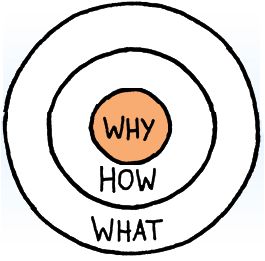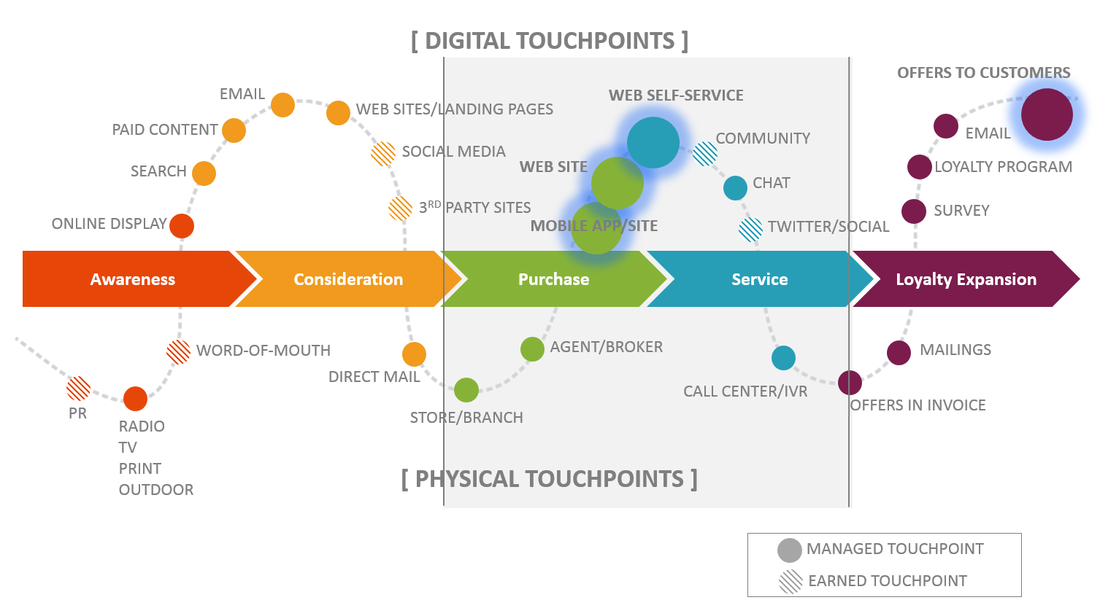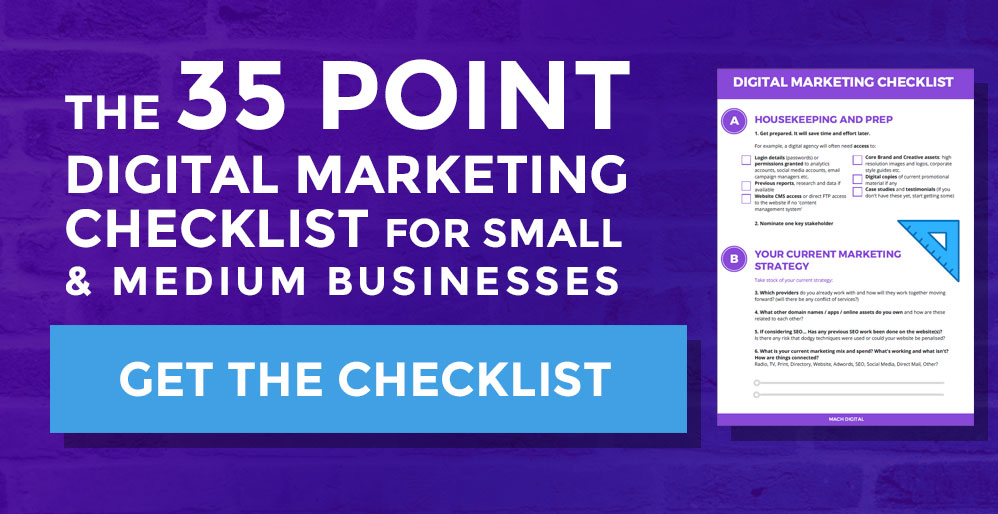|
Take Charge of your Digital Marketing with this 35 Point Checklist
No, this isn't another washed-out guide spouting trends like 'social media will be big in 2017'. Yes, this is a real, step-by-step digital marketing checklist. How do I use it?
Most importantly, we want to help you answer this question:
"We're an [insert company] selling [insert products] in [insert location].
How do we go about digital marketing?"
* The checklist is based on 15 years' working with clients digital-agency-side and similar to the kinds of questions you might get asked in a typical 'client brief' or 'discovery' meeting.
A) To Start... Housekeeping & Prep
Whether engaging with a digital agency for the first time or changing agencies (or even if you aren't), it's always good to have your house in order.
1. Get prepared. It will save time and effort later. For example, a digital agency will often need access to:
This might seem basic at first. But, if we had a dollar for every hour spent chasing down login details over the years... well, you know how it goes...
Also give some thought to: 2. Nominate one key stakeholder This is a primary contact to act as a liaison between your business and the agency. That person should be a filter for any internal conflict and only relay the final decision and comments to the agency as well as acting as a conduit with other service providers to keep information flowing. B) Your Current Marketing Strategy
Take stock of your current strategy:
3. Which providers do you already work with and how will they work together moving forward? (will there be any conflict of services?) 4. What other domain names / apps / online assets do you own and how are these related to each other? 5. If considering SEO... Has any previous SEO work been done on the website(s)? Is there any risk that dodgy techniques were used or could your website be penalised? 6. What is your current marketing mix and spend? What's working and what isn't? How are things connected? Radio, TV, Print, Directory, Website, Adwords, SEO, Social Media, Direct Mail, Other? C) Be Clear on Your Goals
Before you get to the 'marketing' part, it's essential to be clear on the basics.
7. List 3-5 primary goals of your digital marketing efforts.
Be specific. Don't just list 'more sales'. They should also be measurable, agreed upon and achievable (especially if working with a digital agency), realistic, relevant and time-based where possible (SMART). 8. Define what success looks like - what metrics do you plan to track and use to gauge success? 9. In what time frame do you hope to see these results? 10. Which conversion goals do you want people to take? 11. How much is a good conversion worth to you? Consider one-off sales and also the lifetime value 'LTV' of a customer. Some example goals:
D) Your Company
Be consistent in how your company is represented online:
12. Ensure your NAP ('Name', 'Address', 'Phone') and Industry details are consistently formatted, complete and clear on all online portals. *This not only helps people find you online, but it's a local SEO tip too.
13. What's your grand vision / story / purpose? Why does your organisation exist? Don't underestimate the importance of starting with the 'WHY' of your organisation.
14. What are your Unique Value Propositions (or 'Unique Selling Propositions')?
What are the main benefits of your products or services that are unique to your business?
15. Is your business (or products) seasonal? Are sales heavily influenced by the time/season of year or during specific holidays? 16. What is your main business model? How does you business work? For example: Online / offline sales? Retail or wholesale? Physical purchase or mail order? 17. How many staff do you have? What skills or qualifications do they have that are worth highlighting? 18. What memberships or associations is your business part of? Give thought to what logos etc. you need to display and also how you can connect with these groups online. 19. Opening Hours As with point 12 - be clear and consistent with these, including your holiday opening hours. E) Your Products & Services
Understand your highest value products and services:
20. Is your website up to date with your current products/services? Are any of the products listed no longer available? 21. What are your 'hero' products (your most profitable products or services to promote)? 22. How many of these products/services do you sell in a year? How many would you like to sell? 23. What (according to your customers) makes them choose your products or services? 24. Why do clients come back to you/repeat purchase? F) Your Audience
Get to know your audience.
25. In which geographic areas do you operate and where could you expand to? 26. Are your current customers your ideal customers? Why (or why not)? 27. Who do you most want to reach? 28. 'Personas' - What do your most valuable customers look like? Personas are semi fictional representations of real customers. ** Repeat points 28 a-t for at least 2-3 'ideal customers':
Digital Marketing opens up many opportunities to identify and target your customers. Take advantage of this: understand your customers, go where they are and make your marketing investment count. G) Your Competitors & Industry
We're not suggesting you 'copy' your competitors, but you should understand what they are doing and how your audience is used to receiving information in your industry
29. Who are your 3 biggest direct competitors? 30. Which channels do competitors typically use to compete online in your industry? (Video, SEM, SEO, Social Media, other) 31. What's the size of your industry and your current Vs desired market share? 32. Is your industry price-sensitive? Are there any other specific ways competitors compete in your industry? Seasonal discounting, value-add products, free quotes etc. 33. How are you currently positioned in your industry? Are there any opportunities or threats? 34. Are there specific words or phrases (or 'industry jargon') people might search for ONLY in your industry? 35. Are there specific promotions you would normally run? When and how could you run these on digital/online channels? Who would you target and why? Putting It Into Action - AKA 'The Marketing Part'
Now, what do you do with this information?
Hopefully you've already had a few light bulbs turn on during this process and some ideas are flowing. If not, then engaging with a digital marketing consultant or digital agency can certainly help you kick start things, avoid any costly mistakes and set you in the right direction. If you still want to give it a try yourself first, here are a few tips:
What works for your business and customers will not be the same as someone else, even if they are in the same location and industry. The diagram below gives an example of what you could focus on at various stages of the customer journey, and which channels may be effective. But this is only a guide; always start with your business goals first.
A few thoughts and ideas:
a) If you need more awareness or are looking to influence buyers during the consideration stage you could:
b) If your goal is more activations or purchases, perhaps:
c) Or are your customers likely to make repeat purchases or refer friends?
And don't forget - d) In all of this, it's important to make sure your website:
You don't want to be 'pouring water into a leaky bucket'! Get the 35 Point Digital Marketing Checklist PDF
Free PDF version available for download.
No annoying popups or email address required!
2 Comments
31/10/2017 04:54:39 pm
Using digital marketing a business can reach out to a wider range of targeted customers to increase its business prospects. Thanks for the wonderful Article.
Reply
MACH Digital
6/11/2017 06:55:16 pm
Thank you for your comments - we're really glad that you found the guide and article useful.
Reply
Your comment will be posted after it is approved.
Leave a Reply. |







 RSS Feed
RSS Feed
